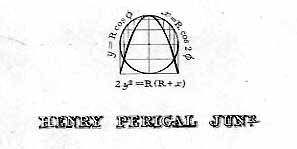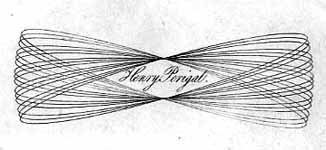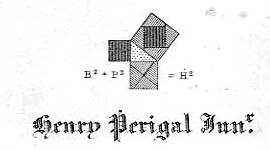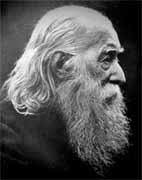Henry Perigal Jr
Quick Info
Newington, Southwark, London, England
St Giles, London, England
Biography
Henry Perigal Jr was the son of Henry Perigal Sr (1768-1867) and Louisa Brady (1770-1827). Henry Perigal Sr, born at Norton Folgate, Spitalfields, London on 19 July 1768, married Louisa Brady, born 17 November 1770 at Alverstroke, Southampton County, at Arundel Church, Sussex, England on 2 November 1799. Henry Perigal Jr, the subject of this biography, was the first of his parents' six children having the siblings Louisa Perigal (1802-1805), Caroline Perigal (1804-1888), George Perigal (1806-1855), who became a well-known chess player and Honorary Secretary to the London Chess Club, Louisa Ann Perigal (1808-1876), and Frederick Perigal (1812-1905), who spent forty years in the Admiralty. Henry Perigal Sn became Assistant Secretary to the Victualling Board working in the Admiralty Office. He lived to the age of 99, being one of thirteen children, nine of whom [2]:-... attained respectively their 64th , 67th , 77th , 80th , 88th , 90th , 94th , 97th , and 100th year - the last five averaging 93 years 100 days.We have to remember that, although this does not seem remarkable by today's average life span, in 1800 the average life span in the UK was only 40 years.
Louisa Brady was the daughter of Lieutenant James Brady, R.N., and Ann Farrington.
The family's ancestry went back to [4]:-
... Sigurd the Dane, who in 908 made a successful raid on Normandy, assumed the name of Perigal, and settled in France. The English branch of the family sprang from Gideon Perigal and his wife, Madeline Duval of Dieppe, Huguenots who escaped to London. Henry Perigal belongs to the tenth generation of their descendants.The family background is described in detail in the work [10] by Frederick Perigal, the youngest of the siblings.
Henry Perigal was 67 years old when his father, also named Henry Perigal, died so for most of his adult life he was known as 'Henry Perigal Junior', while his father was 'Henry Perigal Senior'. Henry Perigal Sr was friendly with John Holt Ibbetson, who was an inventor who published works such as Specimens of Eccentric Circular Turning, with Practical Illustrations for producing Corresponding Pieces in that Art (1817) and A Brief Account of Ibbetson's Geometric Chuck, manufactured by Holtzapffel & Co., with a selection of 32 Specimens, illustrative of some of its powers (1833). This was friendship which became important for Perigal, the subject of this biography, as we shall see below.
Perigal, who was known by the nickname "Cyclops" (in fact Cyclops, in brackets, is carved on his tomb), seems to have had a variety of jobs over the first forty years of his life but the main one was as a clerk in the Privy Council Office. From the 1840s he worked as a bookkeeper for his friend Henry Tudor who was a stockbroker operating from an office at 29 Threadneedle Street, London. Perigal continued working for Henry Tudor & Son, Stockbrokers, and only retired from the firm when he was 87 years old. He never married and we see from the UK census the different families that he lived with as a visitor or lodger. In both the 1841 and 1851 census he was living as a visitor with the Green family, a widow Sarah Green living with a daughter, two sons and a servant, at 5 Smith Street, Chelsea, London. He is living that this address in 1843 and writes a paper from it in August 1849. In February 1853 he gives his address on a paper as Cheyne Walk, Chelsea. An article written in 1856 gives his address as 26 Brompton Square, London, but at the time of the 1861 UK Census he is described as a visitor living with the large Fulkan family, the head of the family being Hamilton Fulkan, a civil engineer. The family had a nurse, a cook, two housemaids and a groom. On a paper Perigal wrote in 1869 he gives the address 57 Warren Street, Fitzroy Square. At the time of the 1871 UK Census, he was living as a lodger with artists and painters, Paul Ganci, his wife and two nieces, at 9 North Crescent, Bedford Square. He continued living there, this being his address up to the time of his death in 1898.
From the time he was young, Perigal was interested in curve tracing using Ibbetson's geometric chuck, a tool used in ornamental wood turning. The obituary in Leonard J Rogers' article [12] states:-
To this subject he brought to bear great patience, perseverance, and delicacy of manipulation. Many of the curves so drawn by him between 1830 and 1840 are exquisite examples of fine geometrical tracings performed by means of the bow pen.For the whole of the obituary of Perigal in Leonard Rogers' article, see THIS LINK.
In 1843 Augustus De Morgan published the article Trochoidal curve in the Penny Cyclopaedia. He ends this article as follows:-
... we wish to call attention to the fact that the specimens of curves in this article are all the product of machinery. We are indebted for them to the kindness of Mr Henry Perigal, of Smith Street, Chelsea, a gentleman whose pursuits are scientific, and who practices the higher branches of turning as an amateur, and has devoted much time and money to the investigation of the effects of combined motions, as shown in the curves, resulting from them. Most of those given in this article were executed in his lathe by means of Ibbetson's geometric chuck, a contrivance the results of which are well known to turners, but which have never been exhibited, as far as we know, in any article professing to give a mathematical classification of them.Perigal's geometric chuck can be seen at THIS LINK.
Before looking in more detail at Perigal's ideas and inventions, we should make it clear that although he did some nice geometric work, most of his ideas relating to astronomy were incorrect. The reader might well ask: "Why is he being included in this archive if many of his ideas were incorrect?" Perigal was an eccentric man but also clever. Although many of his ideas were incorrect, they were well thought out and made those with the correct ideas justify what they believed in. Many leading mathematicians and astronomers were his friends, made use of his skills, and were happy to see him raise issues which led to vigorous discussions, many in print. His friends included George Biddell Airy, William Henry Mahoney Christie (1845-1922) (an Astronomer Royal), Lord Kelvin, Lord Rayleigh, George Gabriel Stokes, Silvanus Phillips Thompson (1851-1916), James Whitbread Lee Glaisher and James Joseph Sylvester.
He did some nice work on proving classical geometry theorems which only reached a wider audience after James Glaisher suggested he contribute some short papers to the Messenger of Mathematics in 1872. In the first of these papers Perigal writes [9]:-
The present series of papers consist chiefly of notes and diagrams extracted from my note-books and sketches made during the last forty years. I have devoted much time and thought to the solution of geometric theorems and problems by dissections and transpositions, viz. in proving the equality of areas in equivalent rectangles, &c., and investigating how the figures could be best dissected, so that their component parts might be fitted together in either form, and I have often contemplated proving all the suitable Theorems and Problems in Euclid by such dissections and transpositions, so as to render them self-evident by ocular demonstration.The article [8] contains Perigal's symmetrical dissection approach to Pythagoras' Theorem for which he is best known today. He was so proud of it that the diagram was engraved on his tombstone. You can read a version of the article at THIS LINK.
Spencer Compton, the 2nd Marquess of Northampton (1790-1851), was a well-known patron of the arts and sciences. He served as president of the Geological Society of London in the 1920s and as president of the Archaeological Institute of Great Britain and Ireland (1845-46 and 1850-51). In 1838 he became president of the Royal Society of London, continuing to serve in this role for ten years. Perigal was a regular at Saturday evening soirées of the Marquess of Northampton, and he exhibited various instruments at these events. Several were reported in the Literary Gazette where quite full descriptions of Perigold's ideas are given; we learn that his exhibits attracted the most attention. On the soirée of 21 March 1846, Perigal exhibited an instrument:-
... generating retrogressive or recurrent curves, by which the moving body, when it has reached the extreme points of the curve, retrogrades or returns back in exactly the same line along which it advanced; constantly moving forward and backward from one extremity to the other; and always tracing and retracing the same line as it alternately advances and recedes.He showed parabola-like curves which formed figure-of-eight figures and suggested that comets, following orbits computed to be parabolas, may follow such closed orbits. In the next soiree on 7 April 1846 he exhibited another instrument which produced parabola-like curves but, unlike the one from the pervious session, they did not cross over their paths but had a single closed loop. Again he suggested a possible comet connection. On the Marquess of Northampton's soirée of 13 February 1847 he presented his theory that the Moon did not rotate and illustrated his theory with instruments. This soirée was described in the Illustrated London News of 20 February 1847 where it states:-
The evening event was held at the Marquis of Northampton's London home on The Terrace, Piccadilly. The location of the conversazione is described in contemporary accounts: 'The suite of saloons is four in number: the first, facing Piccadilly, being the reception-room. The several apartments are decorated in that quiet, elegant style by which the older London mansions of our nobility are so happily distinguished ... It is customary, at réunions like the present, to assemble models of new inventions, rare works of art, and other productions of genius, for the gratification of the company'.You can read reports of Perigal's contributions to these soirées at THIS LINK.
Perigal's incorrect views on astronomy did not prevent him being elected a fellow of the Royal Astronomical Society (he was elected on 8 February 1850). Pparticularly given his friendship with several fellows of the Royal Society of London, including the president, the Marquess of Northampton, he hoped also for election to the Royal Society of London. Frederick Perigal writes in [10]:-
Mr Perigal was desirous of being elected a Fellow of the Royal Society, believing that his investigations in curvilinear motion; his mechanical contrivances; and his services in various branches of science, entitled him to that distinction; but he was aware that his known opinions, respecting certain dogmas relating to Astronomy - not being orthodox - would be likely to militate against his admission; and so it proved when his name was put to the vote (when it is probable that many of his personal friends voted adversely); he was naturally disappointed with the result, but observed that his possessing an open mind in all questions, and not adopting doctrines without his judgment assented thereto, should be a reason in his favour, instead of against him.Perigal's completely false idea that the Moon did not rotate seems to have become one of the main obsessions in his life. There must have been a debate about it at the Astronomical Club in January 1865 when John Couch Adams argued the case for the moon to rotate and Perigal the case for non-rotation. His diary entry for 13 January 1865 reads [10]:-
Dined with the Astronomical Club; after dinner, the question as to the moon's rotation was put to the vote, when the numbers were: 10 for Adams and rotation, 11 for Perigal and non-rotation.This shows that, even among astronomers, he was not alone in his false beliefs. Augustus De Morgan reviewed one of Perigal's 'moon theory' papers in [3] and writes:-
Mr Henry Perigal helped me twenty years ago with the diagrams, direct from the lathe to the wood, for the article 'Trochoidal Curves,' in the 'Penny Cyclopaedia'; these cuts add very greatly to the value of the article, which, indeed, could not have been made intelligible without them. He has had many years' experience, as an amateur turner, in combination of double and triple circular motions, and has published valuable diagrams in profusion. A person to whom the double circular motion is familiar in the lathe naturally looks upon one circle moving upon another as in simple motion, if the second circle be fixed to the revolving radius, so that one and the same point of the moving circle travels upon the fixed circle.Perigal never gave up trying to convince others that the moon did not rotate [4]:-
Mr Perigal commenced his attack upon the moon for moving about her axis, in the first of the tracts above [On the phenomena arising from the diurnal rotation of the Earth on its own axis, and its annual revolution round the Sun], ten years before Mr Jellinger Symons, but he did not think it necessary to make it a subject for the 'Times' newspaper; His familiarity with combined motions enabled him to handle his arguments much better than Mr J Symons could do: in fact, he is the clearest assailant of the lot that turned out with Mr J Symons. But he is as wrong as the rest. The assault is now I suppose, abandoned, until it becomes epidemic again. This it will do: it is one of those fallacies which are very tempting. There was a dispute on the subject in 1748, between James Ferguson and an anonymous opponent; and I think there have been others.
... there is no masking the fact that he was a paradoxer pure and simple, his main conviction being that the Moon did not rotate, and his main astronomical aim in life being to convince others, and especially young men not hardened in the opposite belief, of their grave error. To this end he made diagrams, constructed models, and wrote poems; bearing with heroic cheerfulness the continued disappointment of finding none of them of any avail.Others were motivated by Perigal's curves. For example, in 1865 Edward Sang published the paper On the Contact of the Loops of Epicycloidal Curves in volume 24 the Transactions of the Royal Society of Edinburgh. Sang begins the paper as follows:-
During the summer vacation, Mr Henry Perigal of London proposed to me the following problem: "To determine the proportions of an epicycloid of which the loops touch each other."Another example is Perigal's offer, in 1868, of a prize of £10 if somebody could identify a curve he had discovered with his 'two circles machine'. [Note. £10 in 1868 is the equivalent of over £1000 today.] Who found Perigal's curve and won the generous prize? None other than James Clerk Maxwell.
The solution of this problem contains some points of interest to the general analyst, and exhibits relations between certain trigonometric formulae and algebraic equations. I, therefore, offer an outline of it to the attention of the Royal Society of Edinburgh. Mr Perigal had obtained the solution, in a considerable variety of cases by the method of trial, aided by mechanical appliances, and has exhibited them in his beautiful series of machine-engraved epicycloids.
Many of Perigal's inventions are now held by the South Kensington Museum. In their 1876 Catalogue of the Special Loan Collection of Scientific Apparatus [14] the following seven items devised by Perigal are listed:
- Compound Geometric Chuck, producing the kinematic retrogressive parabola, by continuous motion; either on a moving plane by a fixed point, or on a fixed plane by a moving point.
- "Soldier Experiment." Model designed to demonstrate the relative effects of revolution and of rotation, separate or combined, by the movements of soldiers.
- Compass Experiment, demonstrating that a magnetised needle does, but an unmagnetised needle does not, maintain its parallelism while revolving in a circle.
- Gyroscope, demonstrating the effects of revolution and of rotation, the two ways of turning round.
- Gyroscope, demonstrating that revolution alone will account for our always seeing the same face of the moon.
- Selenoscope, to demonstrate the kinematic effects of the three hypotheses of the moon's motion, as a satellite of the earth.
- Kinescopes, illustrating the laws of compound circular motion, by ocular demonstrations of their representative curves, shown by bright beads revolving with great rapidity.
When our Society was formed [1865] he would have liked to join it at once, but feared that his paradoxical views on the subject of astronomical motions would disqualify him; he was much pleased therefore when, some years later, De Morgan offered to propose him as a member and signed his nomination form.He served on the Council of the Royal Microscopical Society and attended meetings of the Royal Institution for many years, becoming a member in 1895 at the age of 94 [13]:-
... supported by various dignified figures: chemist William Crookes, electricians William Preece and David Hughes, physicists C V Boys and Silvanus Thompson, and Augustus Stroh, the inventor of the horn violin.He was elected to the Association for the Improvement of Geometrical Teaching in 1874. He was enthusiastic about all these societies [12]:-
He was a member of the Astronomical, Microscopical, Meteorological, Photographic, and several other scientific Societies, and a very regular attendant at the meetings of all, usually staying to the end, and often being the last to leave; and it may be said that for thirty or forty years, during eight months of the year, he divided his time between daily office work at 29 Threadneedle Street and evening attendance at the meetings of scientific societies, the lectures at the Royal Institution, &c.As to Perigal's character, the following description is given in [12]:-
He was a warm friend, and a pleasant companion, gentle in manner, amiable, kind-hearted, and generous, interested in the topics of the day, and shrewd without being cynical. He rarely left London, and probably never went abroad in the last half of his life. At some time he had made a voyage to Madeira. Twenty years or more ago he let his beard grow, and since then his refined face, slight and fragile form, and long white beard and hair, made him a striking and picturesque figure. He ceased to attend scientific meetings two or three years ago, and for the last year or more had ceased to leave his lodgings; but there was no failure of mind or eye-sight.We can see something of his character from his calling cards which depict what he considered to be his "best" results. Here are three of the cards, his "parabola", "figure-of-eight curves", and his "Pythagoras dissection":



Perigal remained remarkably fit and healthy until well into his 90s [4]:-
He was remarkably vigorous until the last few years, and it may be recorded that on the occasion of the 90th birthday of Sir G B Airy [27 July 1891] - which was celebrated on Saturday 25 July by a reception at the White House, Greenwich Park - Mr Perigal walked up the steep Croom's Hill to the reception without apparently the least distress, being himself a year older that the distinguished nonagenarian. During the last year or two, however, his strength had failed, and he died peacefully on 6 June 1898.After he died his wishes were carried out that he be cremated at Woking in Surrey, and his ashes were buried in the churchyard of the Church of St Mary and St Peter in Wennington, Essex. His tomb carries several inscriptions and diagrams of his Pythagoras dissection theorem and his parabola construction. See THIS LINK.
References (show)
- B Casselman, On the dissecting table. Henry Perigal 1801-1898. +Plus Magazine (1 December 2000).
https://plus.maths.org/content/dissecting-table - Complimentary Dinner to Mr H Perigal, Quarterly Journal of the Meteorological Society 19 (86) (1893), 154.
- A De Morgan, A Budget of Paradoxes; On the phenomena arising from the diurnal rotation of the Earth on its own axis, and its annual revolution round the Sun, Astronomical Register 3 (1865), A2:4-A2:6.
- Henry Perigal, Journal Royal Astronomical Society 59 (5) (1899), 226-228.
- H Perigal, Appendix to No. 29. A Budget of Paradoxes; On the phenomena arising from the diurnal rotation of the Earth on its own axis, and its annual revolution round the Sun, Astronomical Register 3 (1865), A2:4-A2:6.
- H Perigal, Perigal's Contributions to Kinematics (1859).
- H Perigal, A Collection of Pamphlets, Reprints and Ephemera (1840).
- H Perigal, Miscellaneous physical and mathematical papers.
https://www.google.co.uk/books/edition/Miscellaneous_physical_and_mathematical/DCVbAAAAcAAJ?hl=en&gbpv=1&dq=Henry+Perigal&printsec=frontcover - H Perigal, On Geometric Dissections and Transformations, Messenger of Mathematics (2) 1 (1872), 103-106.
- F Perigal, Henry Perigal, a short record of his life and works Extracts from His Diaries, and Reprints of Occasional Notices and Obituaries from Scientific and Other Publications, Accompanied with Illustrations of Specimens of a Few of His Designs, Both by the Bow-pen and Lathe (Bowles & Sons, 1901).
- F Perigal, Some Account of the Perigal Family (Harrison and Sons, London, 1887).
- L J Rogers, On certain Regular Polygons in Modular Network, Proc. London Math. Soc. 29 (1) (1897), 706-735.
- L Scales, Henry Perigal, the Respected Crank, The Royal Institution (2014).
https://www.rigb.org/blog/2014/december/henry-perigal - South Kensington Museum, Catalogue of the Special Loan Collection of Scientific Apparatus at the South Kensington Museum (George E Eyre and William Spottiswood, London, 1876).
Additional Resources (show)
Other pages about Henry Perigal:
Other websites about Henry Perigal:
Cross-references (show)
Written by J J O'Connor and E F Robertson
Last Update March 2021
Last Update March 2021
